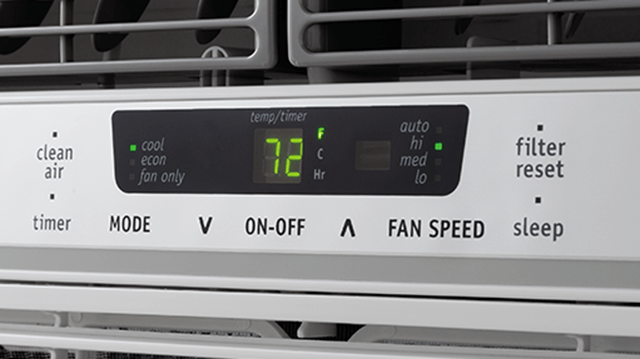I grew up in an old house without an air conditioner. During the summer, it would get so hot and humid that the doors would swell, and you couldn’t close them. So when it was finally time for me to buy my very own AC unit, it felt like a luxury. And I treated it as such.
Of course, an AC unit isn’t really a luxury good. As far as home appliances go, they’re relatively inexpensive and easy to install. They’re also an appliance you’ll interact with a disproportionate amount, and if that relationship isn’t working out, they’re a pain to return. So it’s important to get it right the first time.
Unfortunately for me, I got it wrong. So that you don’t repeat my mistakes, I’m going to walk you through my quest to find the perfect air conditioner. It will be a pretty chill experience for the both of us. (Sorry about that pun.)
The Bright Beginning
As my little tale about sweating through my youth in the Southern heat should have revealed, I was a beginner in the art of AC-buying. And in many ways, it is an art.
Buying an AC is a lot like finding a good pair of shoes on a sale rack, except all the shoes look the same. You’re given a set of aconstraints — the size of the window and the size of the room, namely — and then you have to struggle to find the right unit. For standard windows, you’ll need a a standard unit, and for small windows you’ll want a smaller one. The size of the room simply dictates how many BTUs you’ll need to keep it cool. (BTU stands for British Thermal Units and represents the amount of energy required to heat or cool one pound of water by one degree Fahrenheit. Here’s a good explainer on how that applies to AC units.)
All that said, most of the major manufacturers make AC models in different sizes and cooling capacities, so you’ll have options. The problem, again, is that they pretty much all look the same.

I was looking for two units for two bedrooms in my apartment. Like many spaces in New York City, my bedroom is small. My roommate’s was slightly bigger, but a little bit of research and simple maths told me that a 6000 BTU unit would cool either 150-square-foot room just fine. That same research also told me that a going with a higher BTU did not necessarily mean a colder room and could possibly mean a more humid room. (Yuck.) Basic features like a thermostat and remote seemed pretty standard across all the different units. So once I landed on that 6000 BTU number, I was ready to do some business.
On the advice of our friends at The Sweet Home, I bought two energy-efficient units made by Frigidaire. (That’s its archaic-looking control panel, above.) Then the fun really started.
The Muddy Middle
When the units arrived in the mail, I was excited. I lugged them up the stairs. I cut open the box, and I pulled out our new toys. “What luxury this oblong white box would bring,” I thought to myself. That cold, crisp air would make me feel so pampered, like staying in a fancy hotel!
Once I got the heavy things positioned in the window, I turned one on with a remote and sat back, ready for my regal experience. Then I realised a couple of stark realities about AC units. They’re terribly loud, for one, and they also don’t cool rooms down instantaneously. It takes at least 15 minutes and usually some tweaks. In the coming days, I’d learn that window units require a lot of touching. Staying comfortable requires constant adjustments based on the weather outside, who’s in the room with you and so forth.
After a couple of weeks, those stark realities really set in, and I got upset. Though it cooled my room well enough, my noisy unit often produced a rattling noise so loud that it would wake me up in the middle of the night. And though it was the correct cooling capacity in terms of my careful BTU measurements, my roommate’s unit simply couldn’t keep her room cool.
Both issues were bad enough that I contacted Amazon about a return. The company agreed and sent me shipping labels. Then I realised how hard it is to ship an AC unit without the proper packing. (I’d already thrown it out.) Since it was still the middle of the summer, my best bet would be to buy new units and ship the old ones back in those boxes.
The Still Muddy (But Sort of Futuristic) Middle
This is when Aros came into my life. This sparkling white unit by Quirky and GE had been producing lots of buzz. It certainly didn’t help that the companies ran a huge ad campaign in New York City with billboard-sized images of their brand new, Wi-Fi-enabled AC. And I had to admit: It was pretty.
The Aros was also smart — or at least it was advertised as such. The AC unit would fit into Quirky’s Wink ecosystem, a platform for controlling all of your connected home devices from one place. The Wink app enabled Aros owners to control the AC unit from a smartphone, regardless of whether they were home or at the office or even in another state. Some compared the Wi-Fi functionality to the Nest.
The Wink app also let you create so-called robots that would automate the unit’s functions. For instance, if you wanted the Aros to turn on when you get halfway home from the office so that your home would be cool when you arrived, you’d create a robot with a geo-fence. When the GPS chip in your phone indicated that you were the right distance away, the robot would kick in and start up the Aros. Pretty cool, right?
I ordered two of them. The Aros only comes in an 8,000 BTU model, but I figured the extra power would be good for my overheated roommate. Plus, it was so pretty, it must be perfect, right?
When the two Aros units arrived, I was excited. When I pulled the glistening white cubes out of the boxes, I was even more excited. The Aros was the most beautiful air conditioner I’d ever seen. Now, there wasn’t a whole lot of competition in that contest but still, it was something I was proud to put in my window. My roommate, who went to school for design, agreed.

We excitedly installed the things with their glossy perforations and cleverly hidden vents. We plugged them in and gave off a collective, “Ohhhhh!” when the machine fired up, illuminating the formerly invisible bright blue display. Instead of a brain-smashing rattling sound, the Aros gave off a clean, uniform drone, just the type of white noise you want when you’re living on a noisy corner in Brooklyn. It was still loud, but the air felt colder — as it should have given the power bump. And did I mention how pretty the Aros is? We were thrilled.
The End
Happiness never lasts forever. For the rest of the summer, we enjoyed the smooth dependability and sleek design of the Aros. We did not, however, enjoy the futuristic features, because they did not work.
The best word I can use to describe the Wink-powered features on the Aros is not “smart.” It’s “schizophrenic” — or at least the robots are. I can’t list all the examples here, but I’ll point out a couple.
For one, the setup was not the seamless experience I’d gleefully imagined as I hauled boxes up the stairs. I tried connecting to the Aros with both the Android and the iPhone Wink app, and had trouble with each. The iPhone set up actually required a half-hour call to the support team and some very weird button-pushing to get the thing to actually connect to my iPhone. It was frustrating.
My favourite Aros outbursts, however, tended to happen in the wee hours of the morning when my phone was sitting perfectly still next to my bed. I had set up some geo-fences so that the AC would turn and on off as I came and went. But for some reason, Aros often thought I was on the move when I was actually asleep. Once, it thought that I left the house at around 8:12 and returned around 8:12. Then, it thought I left at 8:18 and returned at 8:18. Inevitably, I woke up sweating, because the Aros had turned itself off hours before and the sun had turned my room into an incubator. Either I was sleepwalking, or the Aros was buggy. (I’m not a sleepwalker.)

After to talking to Wink about the issue, I later learned that the company pushed out a major firmware update to Aros that caused some erratic behaviour. I still can’t quite get the smart features to work right, but the on-going struggle serves as a gentle reminder that the Aros is a device equipped with brand new software. New software often has bugs and often improves over time. I remain hopeful.
Not being able to depend on the most innovative features of the Aros AC unit was a bummer, but it wasn’t the end of the world. Once I finally got the Wink app working, I enjoyed being able to turn on my AC from the subway. I turned off the stupid schizophrenic robots and didn’t have the sweltering wake up problem any more. I even kind of fell in love with how the Aros works as a perfect white noise machine. Plus — and this is the most important thing — my room cooled down quickly and stayed cool.
Now that the weather is starting to cool down, I need my Aros less and less. I’m looking forward to whatever software update has to happen so that I can actually use the robot features, but I don’t miss them, because I’ve never had them in the past. But I’m really looking forward to see what happens next year. Will the big AC makers hire good designers and take on the chic Aros? Will someone actually build a unit that offers features comparable to the Nest but also work? Will someone invent the perfect air conditioner?
Who knew you could get so curious about air conditioners! But the simple fact of the matter is that these appliances are huge energy hogs and ripe for innovation. Quirky and GE, I’d bet, are only the first companies to do something really radical. And while they (barely) missed the ball on making the Aros a dream come true, they did solve the ugly problem.
Now if only someone would do the same for stoves.
Picture: Tara Jacoby
